#DKIST
Link
New data from the DKIST solar telescope gives astronomers a more detailed understanding of the Sun's magnetic field Astronomers are getting closer to understanding one of the sun's most mysterious features by collecting data on its magnetic field. The DKIST solar telescope, the most powerful in the world, has provided the most detailed information about the “quiet” surface of the Sun and its magnetic field. This may help explain one of the biggest mysteries in astrophysics - why the outer layer of the Sun (the corona) is hundreds of times hotter than its surface (the photosphere), although it would be logical to expect the opposite. Professor Robertus Erdelyi, a senior research fellow at the Sheffield School of Mathematics and Statistics, said the observations showed a snake-like magnetic field topology in the sun's lower atmosphere, known as the chromosphere. Understanding the geometry of the magnetic field is fundamental to elucidating the various energy processes that govern plasma dynamics in the solar atmosphere. This includes the expected behavior of the magnetic field, which may explain why solar plasma reaches millions of degrees Kelvin. It is assumed that these magnetic fields are also capable of causing the most powerful coronal ejections. [caption id="attachment_72113" align="alignnone" width="780"] DKIST solar telescope[/caption] Using the DKIST solar telescope The DKIST Solar Telescope, launched in 2022, is the most powerful solar optical telescope on Earth. Its resolution would allow a 50 pence coin (28 mm) to be seen from as far away as Manchester to London. Previous research focused on “sunspots”—large, active areas with strong magnetic fields that can transfer energy between the layers of the Sun. However, now scientists have turned their attention to the “quiet sun” - areas without sunspots and with less intense but dynamic magnetic fields. A clear understanding of the magnetic field structure in this region could reveal the secrets of the energy balance in the solar chromosphere. Thanks to DKIST, scientists have discovered an unexpected complexity in the structure of the quiet sun's magnetic field: snake-like structures. Professor Michael Mathioudakis, co-author and director of the Center for Astronomical Research in Belfast, notes that the more complex magnetic field may be due to the process of magnetic reconnection, where magnetic fields pointing in opposite directions interact and release energy, helping to warm the photosphere. These new observations bring us closer to understanding one of the most significant mysteries in solar research.
#astronomical_instrument#astronomy#DKIST#Helioseismology#solar_data#solar_dynamics#solar_imaging#solar_observation#solar_phenomena#solar_physics#Solar_Research#Solar_Science#solar_studies#solar_telescope
0 notes
Text
Nuovi modelli negli strati solari potrebbero aiutare gli scienziati a risolvere il mistero del Sole
Strutture magnetiche su piccola scala del “sole tranquillo” ad alta risoluzione.
Gli astronomi sono un passo più vicini alla comprensione di uno dei misteri solari più duraturi, grazie all’acquisizione di dati senza precedenti sul campo magnetico del Sole.
I dati rivoluzionari raccolti dal Daniel K Inouye Solar Telescope (DKIST) della National Science Foundation statunitense (NSF) alle Hawaii –…

View On WordPress
0 notes
Text

New patterns in sun's layers could help scientists solve solar mystery
Astronomers are one step closer to understanding one of the most enduring solar mysteries, having captured unprecedented data from the sun's magnetic field.
The groundbreaking data collected from the US National Science Foundation's (NSF) Daniel K Inouye Solar Telescope (DKIST) in Hawaii—the most powerful solar telescope in the world—has provided the most detailed representations to date of the magnetic field of the so-called 'quiet' surface of the sun.
An international team of scientists, including researchers from the University of Sheffield, believe the data has implications for how we model energy transfer between the layers of the sun. The research has been published in Astrophysical Journal Letters.
This might help explain one of the biggest conundrums in astrophysics—why the outermost layer of the sun ('corona') is hundreds of times hotter than the surface ('photosphere'), even though the opposite would be expected.
Professor Robertus Erdelyi, a senior co-investigator from the University of Sheffield's School of Mathematics and Statistics, said, "The observations have revealed and confirmed a serpentine topology of the magnetic field in the lower solar atmosphere, often also called the chromosphere. An accurate insight into the magnetic field geometry is fundamental for the understanding of the various energetic phenomena that drive the dynamics of the plasma in the solar atmosphere.
"That includes the much sought after magnetic behavior that may ultimately be responsible for energizing the solar plasma to temperatures of millions of Kelvins. These magnetic fields are also believed to drive the largest and most powerful explosions in our entire solar system, the Coronal Mass Ejections (CMEs). "
Inaugurated in 2022, DKIST is the most powerful, solar, optical telescope on Earth. It enables record-breaking observations of the sun, with a resolving power being the equivalent to seeing a 50p coin in Manchester from London.
The project led by Queen's University Belfast in collaboration with the University of Sheffield, the NSF's National Solar Observatory, the High Altitude Observatory at California State University, the Max Planck Institute for solar system Research in Germany and Eötvös Loránd University in Hungary, harnessed this power to reveal a new, complex, snake-like pattern of energy in the magnetic field.
In the past, much research into the heat variations between the corona and photosphere has focused on 'sunspots'—very large, highly magnetic and active regions, often comparable to Earth in size—that can act as conduits for energy between the sun's outer layers.
Away from sunspots, the so-called 'quiet sun' is covered in convective cells known as 'granules,' typically about the size of France, that harbor much weaker, but more dynamic magnetic fields that may hold the secrets to balancing the energy budget of the chromosphere.
Most observational reports of the past decade have found that magnetic fields are organized in terms of small loops in the quiet photosphere. With DKIST, researchers have detected something unexpected, finding the first evidence for a more complicated pattern consistent with a snake-like variation in the magnetic orientation.
Professor Michail Mathioudakis, Co-Investigator on the research and Director of ARC at Queen's said, "The more complex the small-scale variations in magnetic-field direction, the more plausible it is that energy is being released through a process we call magnetic reconnection—when two magnetic fields pointing in opposite directions interact and release energy that contributes to atmospheric heating.
"We have used the most powerful solar optical telescope in the world to reveal the most complex magnetic-field orientations ever seen at the smallest scales. This brings us closer to understanding one of the biggest conundrums in solar research."
Professor Erdelyi added, "Thanks to this research we may be one step closer in comprehending the sun, our life-giving star.
"These are fantastic results achieved by a combination of junior and senior scientists across a wide range of institutions at both sides of the Atlantic ocean. The DKIST solar telescope, the largest of its kind, has opened revolutionary new avenues in solar physics."
IMAGE....Small-scale magnetic structures of the ‘quiet sun’ at high resolution. Credit: DKIST
0 notes
Text
Nuevos patrones en las capas del Sol podrían ayudar a los científicos a resolver el misterio solar
Los astrónomos están un paso más cerca de comprender uno de los misterios solares más perdurables, después de haber capturado datos sin precedentes del campo magnético del sol.
Los innovadores datos recopilados por el Telescopio Solar Daniel K Inouye (DKIST) de la Fundación Nacional de Ciencias de EE. UU. (NSF) en Hawái, el telescopio solar más potente del mundo, han proporcionado las…

View On WordPress
0 notes
Photo


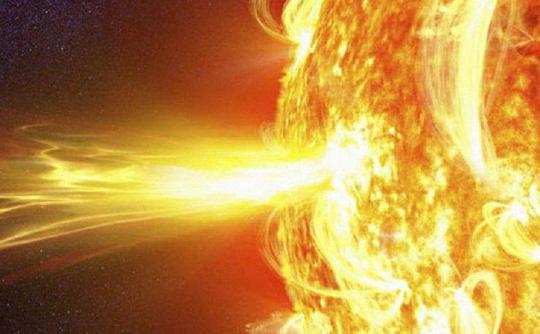







Ask Ethan: How Prepared Are We For The Next Giant Solar Flare?
“a CME the size of the 1859 Carrington Event would, if not prepared for, effectively level the power grid of the United States... Can we actually provide a full day's worth of warning? Is a sufficient warning period actually significant enough to allow us to survive a Carrington class [event?] ...if a Carrington class event were to be detected tomorrow, would we actually be able to survive it effectively?”
It was really only a few days ago that we saw the disastrous effects of what happens if freezing temperatures and power outages occur in a place that isn’t prepared for it. Well, what happens if a space weather event occurs that knocks out power grids globally, potentially not just for days but for months at once?
That’s what we’re facing if we don’t prepare for the next major geomagnetic storm. We just missed one in 2012, near the peak of the last solar cycle. What happens now?
56 notes
·
View notes
Video
youtube
The Daniel K. Inouye Solar Telescope has produced the highest resolution observations of the Sun’s surface ever taken. In this movie, taken at a wavelength of 705nm over a period of 10 minutes, we can see features as small as 30km (18 miles) in size for the first time ever. The movie shows the turbulent, “boiling” gas that covers the entire sun. The cell-like structures – each about the size of Texas – are the signature of violent motions that transport heat from the inside of the sun to its surface. Hot solar material (plasma) rises in the bright centers of “cells,” cools off and then sinks below the surface in dark lanes in a process known as convection. In these dark lanes we can also see the tiny, bright markers of magnetic fields.
16 notes
·
View notes
Note
omg hi ur alive i love u so much & i hope youre eating well & drinking water & taking care of yourself 🌹🌺🌸💓💘🌷
broooooooo maybe i am in love with one zyla [your ambiguous last name] thank you! i’ll remember to and hopefully do u proud with my scraping abysmal gcses 💓
3 notes
·
View notes
Note
💖 ily
💖- have you ever been in love? i have! nd i am right now hehe 😌
ily too angel!
1 note
·
View note
Photo

Beautiful Objects
Daniel K. Inouye Solar Telescope, DKIST
(Maui, Hawaii)
Source: wikipedia.com, idom.com
0 notes
Photo

Incredibly detailed view of the sun captured by Hawaii telescope: Researchers have captured the most detailed view ever of the Sun, thanks to the @nsfgov @nationalsolarobservatory Daniel K. Inouye Solar Telescope (DKIST) on Haleakalā, Maui. #DKIST @UH_IfA #astronomy #solartelescope #haleakala #hawaii https://www.instagram.com/p/B763kojjb6t/?igshid=i6suyzym6xbn
0 notes
Text
im feeling out this url ok
#was @dkist#idk if ill stay seokminswife (though it is#. rightful title) bc the url is too long but im feeling it out
3 notes
·
View notes
Text

High-resolution photo of the Sun.
“Each of the ‘cells’ on the surface of the sun are roughly the size of Texas [pictured for scale]. The resolution of DKIST is about 18.5 miles.” MIT Technology Review
679 notes
·
View notes
Video
youtube
Scientists catch exciting magnetic waves in action in the Sun's photosphere by Queen Mary, University of London Researchers have confirmed the existence of magnetic plasma waves, known as Alfvén waves, in the Sun's photosphere. The study, published in Nature Astronomy, provides new insights into these fascinating waves that were first discovered by the Nobel Prize winning scientist Hannes Alfvén in 1947. The vast potential of these waves resides in their ability to transport energy and information over very large distances due to their purely magnetic nature. The direct discovery of these waves in the solar photosphere, the lowest layer of the solar atmosphere, is the first step towards exploiting the properties of these magnetic waves. The ability for Alfvén waves to carry energy is also of interest for solar and plasma-astrophysics as it could help explain the extreme heating of the solar atmosphere—a mystery that has been unsolved for over a century. Elusive waves Alfvén waves form when charged particles (ions) oscillate in response to interactions between magnetic fields and electrical currents. Within the solar atmosphere bundles of magnetic fields, known as solar magnetic flux tubes, can form. Alfvén waves are though to manifest in one of two forms in solar magnetic flux tubes; either axisymmetric torsional pertubations (where symmetric oscillations occur around the flux tube axis) or anti-symmetric torsional pertubations (where oscillations occur as two swirls rotating in opposite directions in the flux tube). Despite previous claims, torsional Alfvén waves have never been directly identified in the solar photosphere, even in their simplest form of axisymmetric oscillations of magnetic flux tubes. In this study, the researchers used high resolution observations of the solar atmosphere, made by the European Space Agency's imager IBIS, to prove the existence of anti-symmetric torsional waves first predicted almost 50 years ago. They also found that these waves could be used to extract vast amounts of energy from the solar photosphere, confirming the potential of these waves for a wide range of research areas and industrial applications. The research was led by Dr. Marco Stangalini, Italian Space Agency (ASI,Italy) and scientists from seven other research institutes and universities, including Queen Mary's Dr. David Tsiklauri and Ph.D. student Callum Boocock, were involved in this groundbreaking discovery. State-of-the art simulations In addition to these observations, researchers at Queen Mary performed numerical simulations to explore the excitation mechanisms of these elusive waves. The Queen Mary researchers designed and set up a magnetohydrodynamic (MHD) simulation, which are used to model the dynamics of magnetized fluids like those found in the solar atmosphere, to reproduce the team's observations. Dr. David Tsiklauri, Visiting Senior Lecturer at Queen Mary's School of Physics and Astronomy, said: "What was amazing is that our idea that linearly polarized Alfvén Wave driving at the bottom of a magnetic flux tube will result in the generation of torsional oscillations in the entire flux tube held true for a wide range of physical parameters. Both observations and simulations were signaling the discovery of Alfvén waves." Callum Boocock, a Ph.D. student at Queen Mary's School of Physics and Astronomy, said: "The observations of torsional Alfven waves made by Marco and his team were remarkably similar to the behavior seen in our MHD simulations, demonstrating the importance of these simulations for discovering and explaining wave generation mechanisms." The researchers hope to be able to use new opportunities offered by recently commissioned facilities, such as the Solar Orbiter satellite and the ground-based Daniel K. Inouye Solar Telescope (DKIST), to continue to research the relevance of Alfvén waves and potentially further unveil the fundamental secrets of the sun.
1 note
·
View note
Video
youtube
2020 February 3
Solar Granules at Record High Resolution
Image Credit: NSO, NSF, AURA, Inouye Solar Telescope
Explanation: Why does the Sun's surface keep changing? The help find out, the US National Science Foundation (NSF) has built the Daniel K. Inouye Solar Telescope in Hawaii, USA. The Inouye telescope has a larger mirror that enables the capturing of images of higher resolution, at a faster rate, and in more colors than ever before. Featured are recently-released first-light images taken over 10 minutes and combined into a 5-second time-lapse video. The video captures an area on the Sun roughly the size of our Earth, features granules roughly the size of a country, and resolves features as small as 30-kilometers across. Granule centers are bright due to the upwelling hot solar plasma, while granule edges are dim due to the cooled plasma falling back. Some regions between granules edges are very bright as they are curious magnetic windows into a deep and hotter solar interior. How the Sun's magnetic field keeps changing, channeling energy, and affecting the distant Earth, among many other topics, will be studied for years to come using data from the new Inouye telescope.
∞ Source: apod.nasa.gov/apod/ap200203.html
48 notes
·
View notes
Text
This glorious high-res image of a sunspot will take your breath away
https://sciencespies.com/space/this-glorious-high-res-image-of-a-sunspot-will-take-your-breath-away/
This glorious high-res image of a sunspot will take your breath away

The wild, roiling activity of a sunspot can now be seen in mesmerising detail, thanks to a freshly released image from a brand new solar observatory.
In Hawaii, the Daniel K. Inouye Solar Telescope (DKIST) is still in the final stages of completion, but its first image of a sunspot, taken on 28 January 2020 (not the sunspots that appeared in late November), is already the most detailed we’ve seen.
“The sunspot image achieves a spatial resolution about 2.5 times higher than ever previously achieved, showing magnetic structures as small as 20 kilometres (12 miles) on the surface of the sun,” said astronomer Thomas Rimmerle of the NSF’s National Solar Observatory.
Sunspots are of great interest to us here on Earth. Most of the Sun’s surface looks like the popcorn-looking area around the sunspot. Each of those granules is a convection cell; hot plasma rises in the middle, moves out to the edges as it cools, and falls back down into the Sun. And they’re huge – a typical granule is about 1,500 kilometres (930 miles) across.

(NSO/AURA/NSF)
Sunspots are temporary patches where the Sun’s magnetic field becomes particularly strong, inhibiting the star’s normal convection activity. Because hot plasma is prevented by the magnetic field lines from rising from the interior, the sunspot is about one-third cooler than the area around it, and appears darker.
Those magnetic field lines are responsible for another phenomenon that affects us here on Earth. As they tangle, snap, and reconnect, they can release tremendous amounts of energy, unleashing solar flares and coronal mass ejections.
These eruptions from the Sun are so powerful, they can disrupt satellite communications, navigation and, in severe (thankfully very rare) cases, knock out power grids.
So scientists are very keen to learn more about sunspots and how they work – and DKIST, in this picture taken during its commissioning phase (basically testing everything is working correctly), has demonstrated just how powerful it will be in that context.
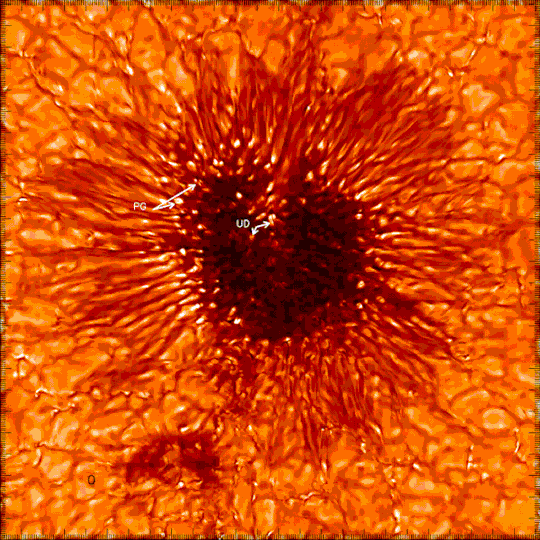
(NSO/AURA/NSF)
The image is about 16,000 kilometres (10,000 miles) across, and Earth, with its diameter of 12,742 kilometres, could fit comfortably inside the sunspot, the researchers said. As they imaged the region, they were able to track changes in the fine structure over short time scales – around 100 seconds. This can be seen in the gif above.
“For example, narrow dark lanes are observed consistently in both umbral dots (UD) and penumbral grains (PG). A few typical examples are pointed out with arrows,” the researchers wrote.
“Narrow, dark lanes within bright UDs and PGs have been predicted by numerical simulations of magneto-convection and are a consequence of strong upflow plumes in areas of lower magnetic-field strength. The dark lanes evolve significantly during 100 seconds giving the impression of small-scale, overturning convection occurring in these features. DKIST’s spectro-polarimeters will allow detailed analysis of these small-scale features and comparison to model predictions.”
Over the coming months and years, DKIST will likely prove invaluable. We’re moving into a period of heightened solar activity known as the solar maximum. These swing around every 11 years, and are characterised by a noticeable increase in sunspots and flares.
A better understanding of the physics behind solar activity is a tool that, scientists hope, will refine our ability to predict solar weather. And that starts with observations.
“With this solar cycle just beginning, we also enter the era of the Inouye Solar Telescope,” said astrophysicist Matt Mountain of the Association of Universities for Research in Astronomy, which manages DKIST.
“We can now point the world’s most advanced solar telescope at the Sun to capture and share incredibly detailed images and add to our scientific insights about the Sun’s activity.”
The team’s paper has been published in Solar Physics.
#Space
1 note
·
View note
Photo


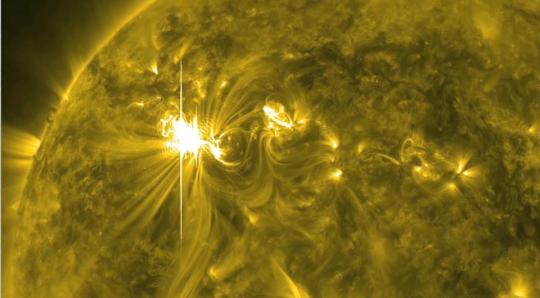

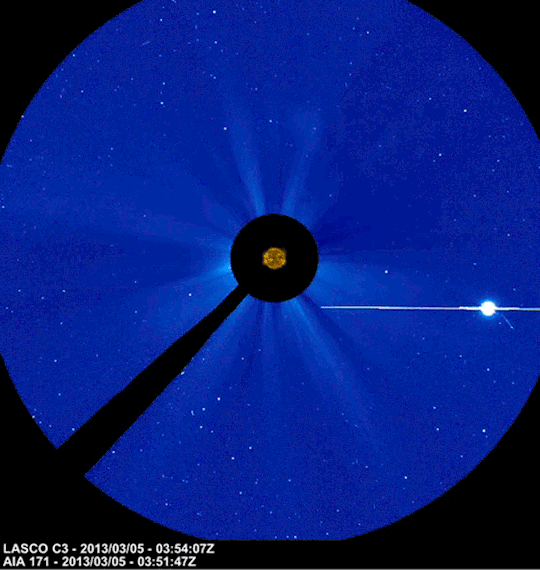
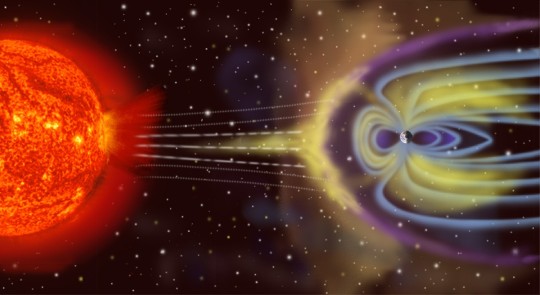
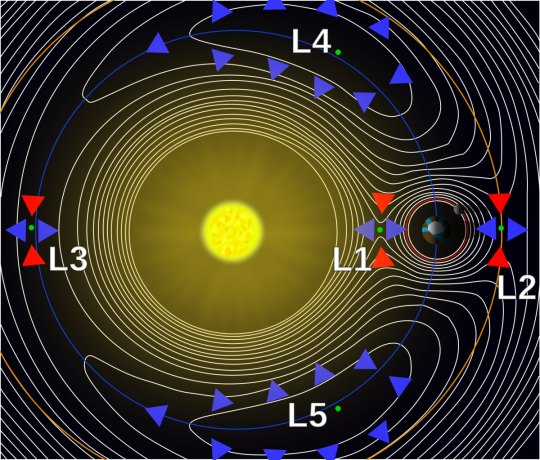
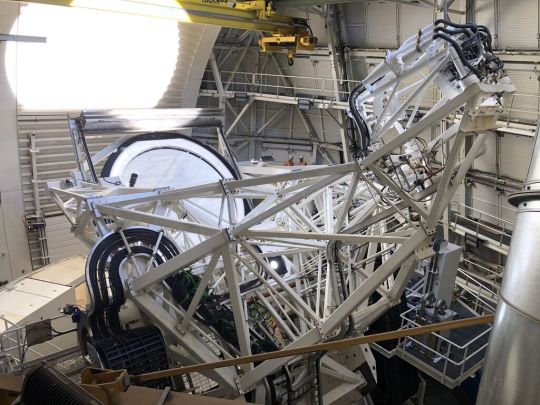


This Multi-Trillion Dollar Disaster Is Coming, And Solar Astronomy Is Our Prime Defense
“Although the largest solar flares are rare, they do occur with some regularity. Some of them create coronal mass ejections; some coronal mass ejections head directly towards Earth; some of the ones that do head towards Earth have exactly the right properties to create spectacular aurorae and potentially catastrophic geomagnetic storms. Only now, with this new generation of solar astronomy tools, are we finally in position to scientifically prepare for the inevitable disaster.
For decades, we've avoided the ruination of our modern infrastructure through sheer luck alone. A Carrington-level event, if it were to strike us unawares, would certainly cause trillions of dollars worth of damage worldwide. With the advent of these new heliophysics-focused observatories, led by the NSF's Daniel K. Inouye Solar Telescope, we'll finally have the opportunity to know when "the big one" is coming.”
In 1859, solar astronomer Richard Carrington was observing the Sun, when a “white light flare” danced around a massive sunspot for around five minutes before disappearing. 18 hours later, the largest geomagnetic storm in recorded history struck Earth. If such an event were to occur today, the induced currents it would create could cause trillions of dollars worth of damage.
But there’s a scientific way to know if one is coming, not just minutes in advance but from the moment the Sun releases a coronal mass ejection: through solar astronomy. In particular, the National Science Foundation’s new Inouye Solar Telescope, whose first light image has delighted the public across the world, will provide our first line of defense against this Sun-driven catastrophe, as well as our first early warning signal.
As spectacular as our first images of the Sun with this new observatory are, there’s a science goal that’s relevant to us all. This is why we study the Sun as we do.
218 notes
·
View notes